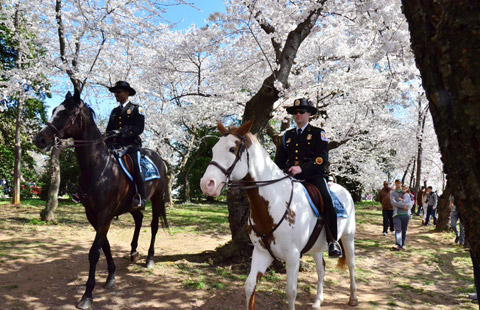Full Text: Tibet's development a historical necessity
Updated: 2015-04-15 11:13
(Xinhua)
|
||||||||
- "Greater Tibet" is sheer fantasy, and does not conform to China's history and national conditions. Talking about the "middle-way" approach by the 14th Dalai Lama and his followers is invariably accompanied by references to "Greater Tibet." In their hypothesis, this "Greater Tibet" extends to southern Xinjiang and the Hexi Corridor in the north, central Gansu and central Sichuan in the east, and to central Yunnan in the south, covering all of the Tibet Autonomous Region and Qinghai Province, half of Sichuan Province, half of Gansu Province, a quarter of Yunnan Province, and the southern part of the Xinjiang Uyghur Autonomous Region. In total, this represents an area larger than one quarter of China's total territory.
In China's entire history, there has never been any geographical entity that supports this concept of a "Greater Tibet." The administrative repartition of contemporary China came into being over a long historical course. During the Tang Dynasty (618-907), the Tubo Kingdom was a multi-ethnic regime established by the Tubo people together with other ethnic groups and tribes inhabiting the Qinghai-Tibet Plateau and surrounding areas. After the Tubo Kingdom collapsed, the Tubo people shared the plateau together with other ethnic groups without any unified regime. During the Yuan Dynasty, the central government set up the U-Tsang High Pacification Commissioner's Office in Tibet to exercise jurisdiction over Tibet, and Do-kham and Domed High Pacification Commissioner's Offices in other Tibetan-inhabited areas. The three High Pacification Commissioner's Offices were under the Commission for Buddhist and Tibetan Affairs (previously the Supreme Control Commission for Buddhist and Tibetan Affairs) of the central government. The central government of the Ming Dynasty set up the u-Tsang Military Command and the Ngari Civilian and Military Command in Tibet, which were later upgraded to the u-Tsang Regional Military Commission. It also set up the Do-kham Military Command in the Do-kham area, which was later upgraded to the Do-kham Regional Military Commission. In 1726, in view of the upheaval in Tibet, the Qing imperial government adjusted the administrative divisions of Tibet and neighboring Sichuan, Yunnan and Qinghai, bringing into being the basic structure of administrative divisions under which the Qing central authorities governed Tibet and other Tibetan-inhabited areas. This structure has remained to this day. Never at any point prior to the peaceful liberation of Tibet in 1951 did the scope of administrative jurisdiction of the local government of Tibet extend beyond the present Tibet Autonomous Region.
"Greater Tibet" was a product of Western colonialist invasions of China and a product of their efforts to split China. The concept is not the brainchild of the Dalai group; it was proposed by British colonialists at the Simla Conference which took place from 1913 to 1914, and it was then written into the illegitimate Simla Accord. The Accord divided Tibetan-inhabited areas in China into "Outer Tibet" and "Inner Tibet"; the former covered the present Tibet Autonomous Region and would have "autonomy," while the latter included Tibetan-inhabited areas in Sichuan, Yunnan, Gansu and Qinghai, to which the Chinese government could dispatch officials and troops. The proposal was rejected outright by the whole of China, and the delegates of the Chinese government refused to sign and recognize the Simla Accord. As a result the Simla Conference broke down, and the Simla Accord never had any status as a legal document.
However, British colonialists continued to foster and support secessionist forces from the upper levels of Tibetan society, who persisted with their plans to achieve "autonomy" with British support. In his later years the 13th Dalai Lama, who had been exploited by British colonialists, finally woke up to what was happening. In 1930, he told Liu Manqing, a representative of the central government, in Lhasa: "Since it is all Chinese territory, why draw lines between yourselves and ourselves? If we allow ourselves to become ensnared in conflict... it is like brothers fighting each other; it makes no sense."
"Greater Tibet" ignores the history and culture created by all the ethnic groups who have lived together on the Qinghai-Tibet Plateau. After many years of contact and exchange, some of China's ethnic groups have spread over vast areas, while others live in individual concentrated communities in small areas. In China, it is quite common that people of one single ethnic group live in different administrative regions, while in a single administrative region there can be many different ethnic groups. On the Qinghai-Tibet Plateau, particularly in its neighboring regions, there have lived more than a dozen ethnic groups since ancient times. These include Han, Tibetan, Hui, Monba, Lhoba, Qiang, Mongol, Tu, Dongxiang, Bao'an, Yugur, Salar, Lisu, Naxi, Pumi, and Nu, all of whom are masters of this land. The present Tibet and the four provinces of Sichuan, Yunnan, Gansu and Qinghai are all multi-ethnic regions, which is the result of a long-term history of exchange, communication and blending among various ethnic groups of China. For reasons of geography, history and customs, different Tibetan tribes are under the jurisdiction of the four different provinces, and have lived together with other ethnic groups in these places over a very long time. In the course of this long history, the Tibetan people, spread across different administrative regions, have both maintained some common features and displayed certain differences in language, customs and other aspects. At the same time, they have engaged in frequent political, economic and cultural exchanges with people of other local ethnic groups, and maintained close ties with them, particularly in the economic field, thus sharing the same or similar regional and cultural characteristics with other local peoples.
"Greater Tibet" disrespects China's national conditions. The system of regional ethnic autonomy is one of the basic elements of China's political system. Regional ethnic autonomy means that the minority ethnic groups, under unified state leadership, practice regional autonomy in areas where they live in compact communities and establish their own organs of self-government to exercise their right of autonomy. Ethnic autonomous areas are classified into the three levels of autonomous regions, autonomous prefectures and autonomous counties. All ethnic autonomous areas are integral parts of the People's Republic of China. After New China was founded in 1949, in addition to Tibet Autonomous Region, eight Tibetan autonomous prefectures, one Tibetan and Qiang autonomous prefecture, one Mongol and Tibetan autonomous prefecture and two Tibetan autonomous counties were set up in Sichuan, Yunnan, Gansu and Qinghai, while in some Tibetan autonomous prefectures there are autonomous counties of other ethnic minorities.Such administrative division takes into account the distribution of different ethnic groups with a view to their future development. It gives expression to the combination of both the ethnical and regional, both political and economic factors that are the outcome of history and contemporary reality, and is conducive to the common prosperity and development of the various ethnic groups in the great family of the Chinese nation. Practice has proven that this system is successful. As the Law of the People's Republic of China on Regional Ethnic Autonomy stipulates in Article 14: "Once established, no ethnic autonomous area may, without legal procedures, be abolished or merged. Once defined, no boundaries of an ethnic autonomous area may, without legal procedures, be altered. Where abolition or merger or alteration is necessary, it will be proposed by the relevant department of the State organ at the next higher level with the organ of self-government of the ethnic autonomous area concerned after full consultation before it is submitted for approval according to legal procedures."
In summary, the concept of "Greater Tibet" the Dalai group seeks to establish runs counter to both history and contemporary reality, and is totally divorced from China's national conditions. "Greater Tibet" disregards the fact that the Qinghai-Tibet Plateau has long been populated by multiple ethnic groups, warps the true history of multi-ethnic development of the plateau into a false single-ethnic history, creates conflict and artificial differences among various ethnic groups of China, and seeks to establish a purely Tibetan "Greater Tibet" exclusive of all the other ethnic groups. It is thus an archetypal expression of racism and ultra-nationalism.
- "A high degree of autonomy" attempts to set up "a state within a state," which contravenes the Constitution and state systems.
"A high degree of autonomy," also described as "true autonomy" or "genuine autonomy," is another core element of the "middle way" advocated by the Dalai Lama and his followers. It purports to pursue the "power of autonomy" in language, culture, religious affairs, education, environmental protection and some other fields, subject to the sovereignty of the People's Republic of China. But, the Dalai party's demands for "a high degree of autonomy" also include claims that undermine national unity, sovereignty and the state systems of China; the essence of "a high degree of autonomy" is to set up "a state within state" free of any control from the central government. The first issue is the relationship between the "autonomous government" and the central government of China. Through "a high degree of autonomy," the Dalai group proposes to establish an "autonomous government" through "democratic elections." "All affairs except diplomacy and national defense should be under the full responsibility of the Tibetan people"; and "Tibetan people should have the power to set up a local government, governmental organizations and institutions that meet their demands and are in line with their characteristics. The people's congresses in autonomous areas have the authority to make laws and regulations for all issues, and the enforcement power and discretionary power in all departments of the autonomous government..."
This actually places the "autonomous government" in a position of independence and removes it from any level of authority exercised by the central government; it establishes an alternative set of political systems by overturning the ones currently effective in Tibet Autonomous Region.
The second issue concerns military affairs in Tibet. The Dalai party takes the position that "Only when troops of the Communist Party of China withdraw completely from the region, can we start real reconciliation." It also demands that "regional peace conferences shall be held to ensure Tibet remains a demilitarized zone," proposing to turn Tibet into an "international zone of peace" and a "buffer between China and India," attempting to move China's internal affairs into the international arena.
Tibet is a component of the People's Republic of China, and the central government stationing troops in Tibet serves as a symbol of state sovereignty and is out of the needs of national security. The Dalai group's opposition to the central government stationing troops in Tibet is clear evidence of its intention to seek complete independence.
The third issue concerns the rights of other ethnic groups. The Dalai group demands that the central government must "prevent further migration into Tibet and return the Han people who have migrated into Tibet back to China." Samdhong Rinpoche, an influential figure in the Dalai group, declared in a speech in 2005, "The whole area inhabited by Tibetan people should be under the regional ethnic autonomous control of Tibetans themselves; Han and other groups are like guests and should not restrict our rights in any form."
As has already been demonstrated, the so-called "Greater Tibet" region, and particularly the neighboring areas of the Qinghai-Tibet Plateau, has for centuries been a corridor of frequent migration of China's different ethnic groups, who have lived together and depended on each other in this region. The Dalai group's logic is absurd and chilling, proposing to force tens of millions of people of other ethnic groups out of this region where they have lived for generations. The net result of "a high degree of autonomy" would be tantamount to an ethnic cleansing of the plateau.
The fourth issue concerns the "one country, two systems" policy. The Dalai group bases its demand for "a high degree of autonomy" on the "one country, two systems" policy; it believes that Tibet is "special" and should have even greater rights of autonomy than Hong Kong and Macau.
"One country, two systems" is a basic state policy adopted by the central government of China to resolve the issues of Taiwan, Hong Kong and Macau, and to realize the peaceful reunification of our country. But the Tibet issue has nothing in common with the situation in Taiwan, Hong Kong and Macau. The Taiwan issue was a carry-over from the KMT-CPC civil war. The issues of Hong Kong and Macau were the direct result of imperialist aggression against China, and they concerned the resumption of sovereignty. Tibet has been an integral part of China's territory since ancient times, over which the central government has always exercised effective sovereign jurisdiction. So the issue of resuming exercise of sovereignty does not arise.
This demonstrates that "a high degree of autonomy" is a mask that conceals the true aim of realizing complete independence; and its purpose is to deny China's sovereignty over Tibet and establish a "Greater Tibet" beyond the jurisdiction of the central government. There is no prospect of it ever coming to pass, for the following reasons:First, it violates the principles of the Constitution of China concerning ethnic relationships. The Constitution states clearly in the Preamble: "The People's Republic of China is a unitary multi-ethnic state built up jointly by the people of all its ethnic groups. Socialist relations of equality, unity and mutual assistance have been established among them and will continue to be strengthened. In the struggle to safeguard the unity of the ethnic groups, it is necessary to combat big-nation chauvinism, mainly Han chauvinism, and also necessary to combat local-national chauvinism." Article 4 says: "All ethnic groups in the People's Republic of China are equal... Discrimination against and oppression of any ethnic group are prohibited; any acts that undermine the unity of the ethnic groups or instigate their secession are prohibited." The Law on Regional Ethnic Autonomy stipulates in Article 48: "The organ of self-government of an ethnic autonomous area shall guarantee equal rights for the various ethnic groups in the area." The Dalai group's demands for "a high degree of autonomy" are an expression of ultra-nationalism that negates the equal rights of ethnic groups in Tibet.
Second, "a high degree of autonomy" runs counter to the present state structure of China. When founded, the People's Republic of China inherited a unitary state structure, with a unitary Constitution and legal system. In China, the state is constituted by local administrative regions rather than local governments. As the Constitution stipulates in Article 57: "The National People's Congress of the People's Republic of China is the highest organ of state power." It also stipulates in Article 58: "The National People's Congress and its Standing Committee exercise the legislative power of the state."

 Oil paper umbrellas made in Sichuan
Oil paper umbrellas made in Sichuan
 Ex-student sought in shooting death of North Carolina college
Ex-student sought in shooting death of North Carolina college
 Women in politics - Hillary Clinton is just one of them
Women in politics - Hillary Clinton is just one of them
 10 Red Dot Award winning carmakers in '14
10 Red Dot Award winning carmakers in '14
 Get a birthday cake for your pets
Get a birthday cake for your pets
 7 ways to beat 'spring sleepiness'
7 ways to beat 'spring sleepiness'
 Legendary painting of Mona Lisa recreated
Legendary painting of Mona Lisa recreated
 National festival underway with cherry blossoms in peak bloom
National festival underway with cherry blossoms in peak bloom
Most Viewed
Editor's Picks

|

|

|

|

|

|
Today's Top News
US to help smart cities
Clinton's win not guaranteed despite global celebrity
US has record number of applications for H-1B tech visas
Chinese economy to slow more: World Bank report
China's slow down has upside
US voluntary medical team funded for China trip
Hilary Clinton launches
presidential campaign
'No room' for election China-bashing: US politicians
US Weekly

|

|






